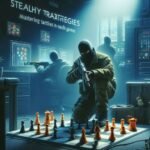Welcome to “Stealthy Strategies,” a comprehensive guide designed to enhance your prowess in stealth-based video games. Stealth games challenge players not only with direct combat scenarios but also with the requirement to navigate through environments undetected, using cunning and tactical skills to outsmart opponents. This guide will explore fundamental and advanced techniques that can transform you into a master of the shadows, helping you to succeed in popular stealth games like “Metal Gear Solid,” “Splinter Cell,” “Dishonored,” and others. Whether you’re a novice looking to improve or an experienced player aiming to refine your strategy, these insights will aid in enhancing your gameplay experience.

Part 1: Foundations of Stealth Gameplay
Understanding the core principles of stealth gaming is crucial to mastering this genre. Here’s how to build a solid foundation:
Awareness of Surroundings
The essence of stealth is awareness. Constantly observe your environment, noting locations of enemies, surveillance equipment, and possible hiding spots. Use the game’s camera angles to your advantage, checking corners and blind spots meticulously.
Noise Management
Managing the noise you make is critical. Walking softly, avoiding loud surfaces, and using gadgets that muffle sounds are essential tactics. Most stealth games have an audio indicator to help you monitor the noise level your actions generate.
Light and Shadows
Manipulate light and shadows to remain unseen. Stay in dark areas and away from well-lit places unless necessary. Use environmental elements to your advantage, such as turning off lights or causing distractions that alter light sources.
Part 2: Advanced Evasion and Infiltration Techniques
As you become comfortable with the basics, start incorporating more sophisticated tactics into your gameplay:
Timing Enemy Patrols
Learn and anticipate enemy patrol patterns. This allows you to move undetected by exploiting gaps in their routines. Patience is key—wait for the right moment before making your move.
Decoy and Distraction
Use decoys and distractions effectively. Throwing objects, triggering alarms in other areas, or using in-game gadgets can divert attention away from your location, opening paths that were previously guarded.
Verticality and Alternate Routes
Don’t just think horizontally—use vertical spaces to evade enemies. Climbing onto ledges, using grappling hooks, or crawling through vents can provide alternative routes that enemies rarely monitor.
Part 3: Non-Lethal Solutions and Escape Strategies
Stealth games often reward non-lethal approaches with higher scores or special achievements. Here’s how to master non-lethal methods:
Non-Lethal Gadgets
Familiarize yourself with non-lethal gadgets available in the game. Tranquilizer guns, stun grenades, and gas that induces sleep are tools that can neutralize threats without causing fatalities.
Subduing Opponents
Learn the mechanics of subduing opponents without killing them. Most games offer options like choking or tranquilizing. Remember to hide unconscious bodies to prevent them from being discovered.
Quick Escape Plans
Always have an escape route planned. Whether you’re caught or completing an objective, knowing how to exit quickly and quietly is essential. Use smoke bombs or flashbangs as last-resort tools to facilitate escapes.
Part 4: Utilizing the Environment to Your Advantage
The environment in stealth games is not just a backdrop but an interactive element that can significantly influence your success:
Interactive Objects
Interact with objects that can aid your stealth mission. Lock doors to funnel enemies, hack systems to create diversions, or destroy objects to block paths temporarily.
Natural Elements
Use natural elements like rain or wind to mask your movements. Environmental noises can cover the sounds of your activities, allowing you to move more aggressively when necessary.
Adaptability
Be adaptable in your approach. If one path is too heavily guarded, look for alternative ways to achieve your objectives. Flexibility and creativity in using your surroundings are marks of an advanced player.








